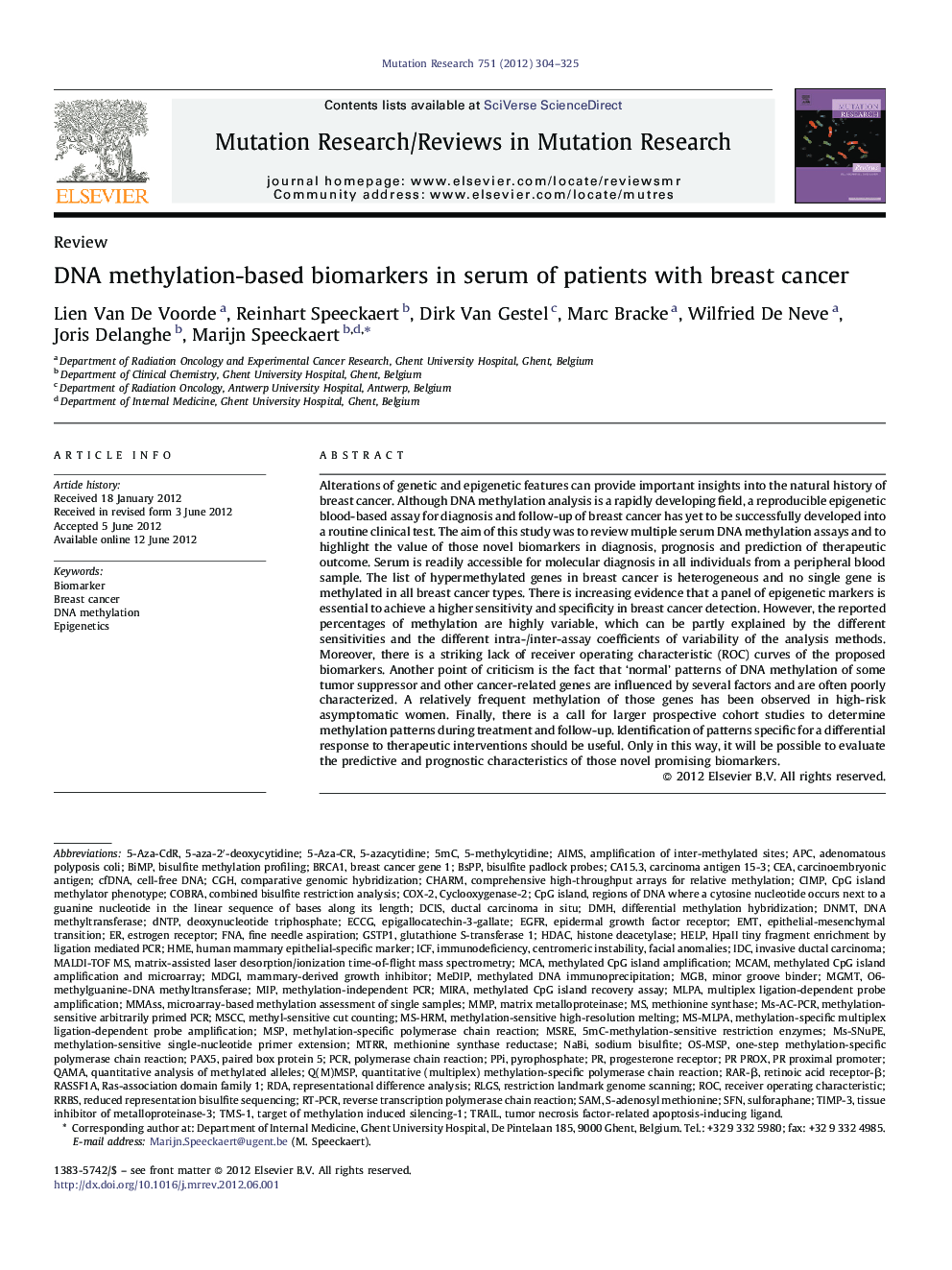| Article ID | Journal | Published Year | Pages | File Type |
|---|---|---|---|---|
| 10915292 | Mutation Research/Reviews in Mutation Research | 2012 | 22 Pages |
Abstract
Alterations of genetic and epigenetic features can provide important insights into the natural history of breast cancer. Although DNA methylation analysis is a rapidly developing field, a reproducible epigenetic blood-based assay for diagnosis and follow-up of breast cancer has yet to be successfully developed into a routine clinical test. The aim of this study was to review multiple serum DNA methylation assays and to highlight the value of those novel biomarkers in diagnosis, prognosis and prediction of therapeutic outcome. Serum is readily accessible for molecular diagnosis in all individuals from a peripheral blood sample. The list of hypermethylated genes in breast cancer is heterogeneous and no single gene is methylated in all breast cancer types. There is increasing evidence that a panel of epigenetic markers is essential to achieve a higher sensitivity and specificity in breast cancer detection. However, the reported percentages of methylation are highly variable, which can be partly explained by the different sensitivities and the different intra-/inter-assay coefficients of variability of the analysis methods. Moreover, there is a striking lack of receiver operating characteristic (ROC) curves of the proposed biomarkers. Another point of criticism is the fact that 'normal' patterns of DNA methylation of some tumor suppressor and other cancer-related genes are influenced by several factors and are often poorly characterized. A relatively frequent methylation of those genes has been observed in high-risk asymptomatic women. Finally, there is a call for larger prospective cohort studies to determine methylation patterns during treatment and follow-up. Identification of patterns specific for a differential response to therapeutic interventions should be useful. Only in this way, it will be possible to evaluate the predictive and prognostic characteristics of those novel promising biomarkers.
Keywords
EGFRcfDNAMMPMCAFNAMIPIDCHMEROCRDASAMPPIDCISCOBRACOX-2RT-PCRHDACDMHEpigallocatechin-3-gallateSFNMGMTAPCMLPAdNTPDnmtMGBICF5-Aza-CdRMSPCGHMSCCCIMPGSTP1TIMP-35-AzacytidineMTRRMeDIPRASSF1ARAR-βPAX5O6-methylguanine-DNA methyltransferaseMSRERRBSMS-HRMCA15.3Reduced representation bisulfite sequencingRLGSMCAMMS-MLPABSPPMDGI5mC5-Aza-2′-deoxycytidine5-MethylcytidineCeAcell-free DNADNA methyltransferaseMethylated DNA immunoprecipitationCpG island methylator phenotypeS-adenosyl methionineadenomatous polyposis coliFine needle aspirationcarcinoembryonic antigenmatrix-assisted laser desorption/ionization time-of-flight mass spectrometryCHARMAIMSEpigeneticssodium bisulfiteBiomarkerrepresentational difference analysiscombined bisulfite restriction analysiscomparative genomic hybridizationmultiplex ligation-dependent probe amplificationEMTCpG islanddeoxynucleotide triphosphateBreast cancerSulforaphaneCyclooxygenase-2TRAILtumor necrosis factor-related apoptosis-inducing ligandmatrix metalloproteinaseMALDI-TOF MSDNA methylationMethionine synthasemethionine synthase reductasemammary-derived growth inhibitorTissue inhibitor of metalloproteinase-3MIRAhistone deacetylasepolymerase chain reactionreverse transcription polymerase chain reactionmethylation-specific polymerase chain reactionPCRPyrophosphateBRCA1Breast cancer gene 1Ductal carcinoma in situInvasive ductal carcinomaHeLPEpithelial-mesenchymal transitionMinor groove binderEstrogen receptorreceiver operating characteristicEpidermal growth factor receptorProgesterone receptorretinoic acid receptor-β
Related Topics
Life Sciences
Biochemistry, Genetics and Molecular Biology
Cancer Research
Authors
Lien Van De Voorde, Reinhart Speeckaert, Dirk Van Gestel, Marc Bracke, Wilfried De Neve, Joris Delanghe, Marijn Speeckaert,
